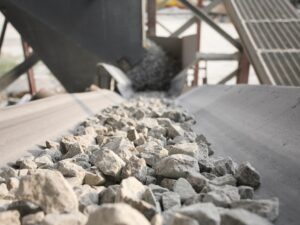
The beginning of a construction project has many moving pieces that ultimately impact the success of your job. One of these elements is selecting construction materials such as sand or gravel. While both sand and gravel come in different forms, each variation has its own strengths and weaknesses. The aggregate experts at ReAgg are here to explain the different types of sand and gravel as well as provide insight into which is best for your project.
Understanding Sand & Gravel
First, it is important to understand the composition of sand and gravel. Both sand and gravel are made of the same base material: sediment that has eroded off of larger rocks. The main difference between the two aggregates is the size. Sand consists of very fine rock fragments or mineral particles that range in diameter from about 1/16 mm to 2 mm. Gravel is larger, and is made up of chipped or rounded rock fragments that typically range in diameter from about 3 to 75 mm.
Sand and gravel deposits come from river channels, river floodplains, and glacial deposits and are produced in all 50 U.S. states. Both materials are extremely versatile aggregates with many uses on construction sites. Construction sand and gravel is used in concrete, road construction, asphalt, construction fill, and in the production of materials such as block, brick, and pipe. Sand can also be used for water filtration as well as landscape material, in the construction of driveways, and parking lots.
With all of these potential uses, it is important to understand the different types of sand and gravel to help determine which ones will be most beneficial for your project.
Selecting the Proper Sand
Not all sand is created equal. At ReAgg, we offer several different kinds of sand, all with their own unique properties.
Concrete Sand
Concrete sand is the standard aggregate that is blended with cement and water to create concrete. Because of the ease in which contractors can adjust the ratio of the mix, cement can take on a variety of forms depending on the project’s specific needs.
Concrete sand is coarser than other types of sand, and is made of rocks such as gneiss, granite, and limestone. The larger particles form strong bonds once the concrete dries, providing a smoother finish than other larger aggregates would.
While the most common use of concrete sand is for concrete or asphalt mixtures, it can be a very adaptable aggregate. Concrete sand can also be used to level out uneven ground, increase traction on icy roads, and act as topdressing for sod and grass. On construction sites, concrete sand can be used for pipe bedding or paver bases, and its size and texture make it ideal for holding pipes, septic tanks, and stones in place while providing adequate drainage. If your project requires utility work or the creation of concrete mixes, concrete sand is a good choice for you.
Masonry Sand
The finest and most versatile sand is masonry sand. Masonry sand is smooth, fine, and clean, and its smaller grains make it more common in projects that require a more visually appealing aesthetic. Masonry sand is the perfect material to fill in gaps and joints between pavers and popular for infill purposes.
In addition, masonry sand is also popular in less construction-related projects such as sand volleyball courts, sand boxes, bases for swimming pools, and footing for horse arenas. Whether you’re laying bricks or adding a new volleyball court to an apartment complex, masonry sand can be essential on your job site.
Thermal Sand
Thermal sand is typically used in projects with underground electrical needs. The insulative properties of thermal sand help to improve underground electrical performance. Electrical cables are conductors. As power is drawn through the cables, a large amount of heat is generated. The insulative properties of thermal sand help to absorb this heat and ensure that the cables do not overheat. If your project has any underground power lines, thermal sand is essential.
Selecting the Proper Gravel
Gravel comes in different sizes and each size is optimal for a different application.
Pea Gravel
Pea gravel is a clean stone mix that is extremely versatile. The smooth, smaller stones have an appealing texture and look, and are optimal for projects that need a softer look. Pea Gravel is often mixed into concrete to create exposed aggregate. In addition, the gravel can also be used as backfill for drainage runs and underground storage tanks. As the choice material for most landscapers, pea gravel is used as a low-maintenance ground cover, in patio mix, and as a stately driveway material.
Washed Gravel
Washed gravel has the same soft, rounded properties as pea gravel. However, washed gravel is larger than pea gravel. Washed gravel provides a high-end, custom look and differs in appearance from the sharp, jagged pieces of crushed gravel.
Gravel becomes “washed” when it has been thoroughly rinsed and screened to remove all dirt and debris. Once complete, washed gravel produces a sheen which landscapers favor. Washed gravel also has natural drainage properties due to its weight and impenetrable surface and often a popular choice for walkways. If your project requires landscaping, washed gravel is a great, low-maintenance option.
Bank Run Gravel
Bank run gravel is composed of the sediment found in riverbanks, including dirt, stones, and minerals. Because bank run gravel is composed of smaller sediments, it is not suitable for high-traffic projects. However, there are many benefits to using bank run gravel in your project. Loose, less traveled roads such as driveways are often constructed with bank run gravel. Because bank run gravel is more compact in nature, debris does not travel through the air as easily, creating a clean experience for those traveling on the road. In addition, bank run gravel can be used to backfill water and other utility lines. It is also a popular choice for base filler material.
Consult with the Aggregate Experts at ReAgg
If you’re beginning a project and are wondering which sand or gravel is right for your needs, let the team at ReAgg help. Our qualified experts will work with you to determine your project’s needs and potential pain points to help select the best aggregate materials. We’ll be there for every step of your project, from material selection to coordinating delivery times. See why we’re more than just stone. Call today for a quote.








